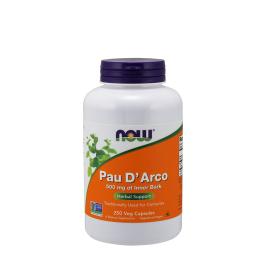Pau d'arco, also known as lapacho, also known as pink trumpet tree (lat.: Tabebuia avellanedae), is a plant native mainly in South America. A beautiful and tall growing pink tree, which is a popular decorative tree.
It has a stong bark, the inner part of which is used in traditional medicine for a variety of purposes, including pain relief, diuretic, anti-inflammatory and to treat candida infections. The bark is used to make lapacho tea. For optimal effects, the tea should be brewed for 8-10 minutes.
Researchers have identified several active substances responsible fot the beneficial effects on the whole body, the most important of which are lapachol and beta-lapachone. These are among the quinone derivatives.
To understand their effects, let's look at where these active ingredients are extracted from. These quinone derivatives are most abundant in the interior of the Pau d'arco bark - it is therefore preferable to use the inner part of the bark (the flake) rather than the whole bark. The dead cells are on the outside of the cortex, but inside the cortex, if you peel off the bark, what do you find? Wet fresh trunks full of life. So the inner part of the cortex contains the old tree cells and the new and fresh cells, this duality gives the inner part of the cortex its medicinal power.
Quinone derivatives have anti-cancer and anti-infective properties. They do this by interestingly being able to trigger reactive oxygen species production - sounds counterintuitive, right? Up until now, it has been on tap that reactive oxygen species are harmful to our bodies because they have cell-damaging effects. This is true, but they also damage cancer cells and infections - because the immune system cells, if they want to kill an infection, can be destroyed by free radicals. So this free radical production is a natural process, but is it not the same whether it affects only the harmful cells or also the healthy ones?
The anti-cancer agents that induce free radical production when used in the right doses only induce the death of cancer cells, because cancer cells produce higher amounts of free radicals in the first place, and stimulating this further can cause cell death, but will not cause cell death in healthy cells (because our free radical production is lower). Conversely, antioxidants (anti-free radicals) can also help in the treatment of cancer, as they are designed to counteract the damaging effects of excessive free radical production by cancer cells on healthy cells.
In addition, antioxidants and quinone derivatives may also act on - prevent - cell division. This further broadens their anti-tumour and anti-infective effects.
Pau d'arco bark therefore strenghtens the immune system in a way that helps to fight infections and cancer cells. Numerous studies have reported that the active ingredient, beta lapachon, may have anti-cancer effects, bringing improvements in breast and prostate cancer, leukaemia and a number of drug-resistant cell lines, among others. In addition, the inner bark of Pau d'arco can improve a number of infections (such as candida albicans, helicobacter pylori, colostridum infections and others).
Dietary supplements (alcoholic liquids, capsules or teas) made from Pau d'arco inner bark are generally considered safe. It has also been registered by the FDA as a natural dietary supplement used in the treatment of cancer, which may cause improvement of condition and reduction of symptoms.
The only reported side effect is vitamin K poisoning, which may occur because Pau d'arco contains vitamin K precursors, so if you use Pau d'arco, stop taking vitamin K or consult a doctor. It is nor recommended during pregnancy or breast-feeding without information. Traditionally, a 15-minute boil of 2-3 teaspoons (10-15) grams of bark is recommended, but the effect of the aqueous solution is not as strong.
Its alcoholic tincture is more effective as a liquid or in capsules. 1-2 ml three times a day or 2-4 500 mg capsules per day are recommended. Stick to these doses to avoid side effects. Use for 6 weeks, then take a break of at least 2 weeks.



